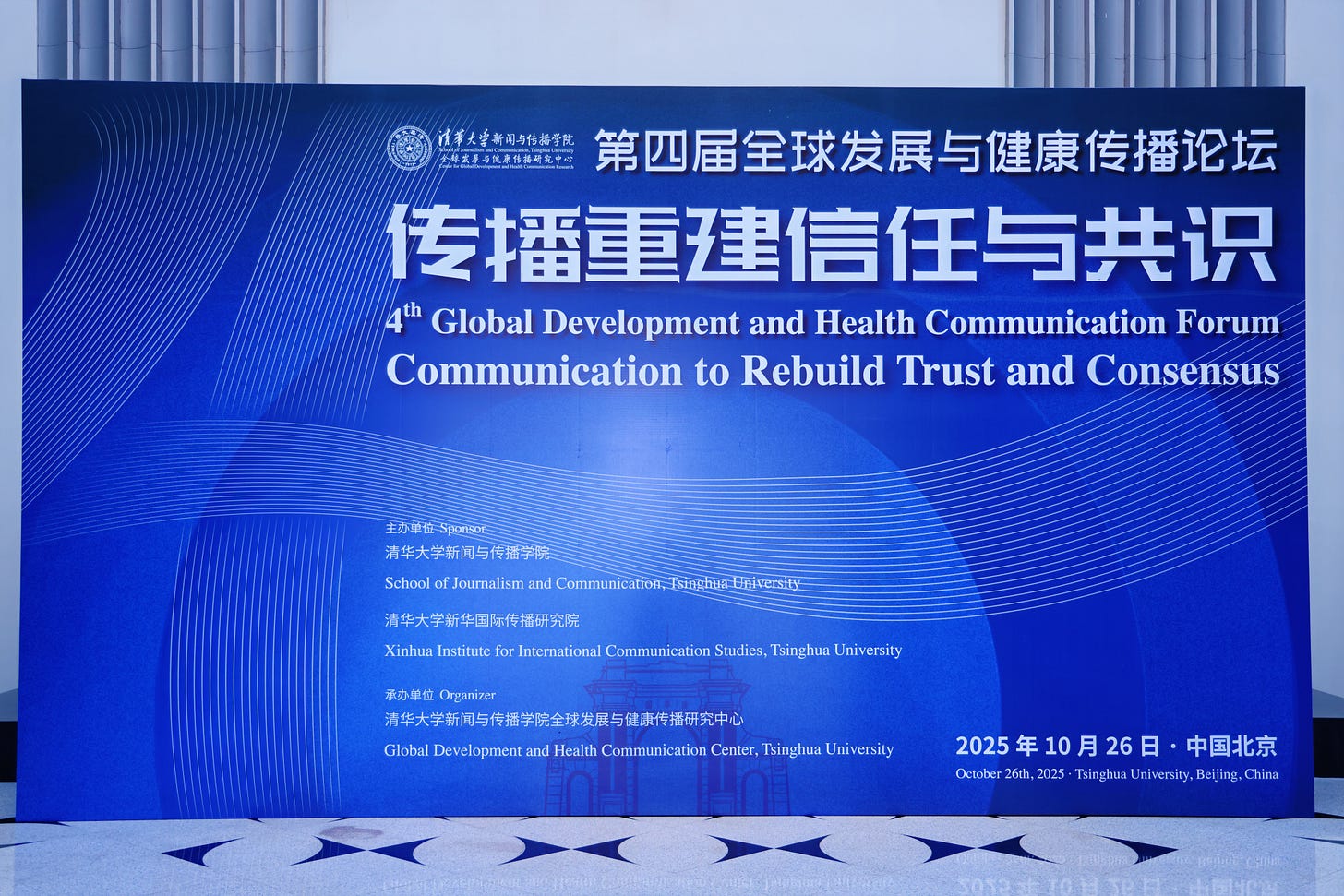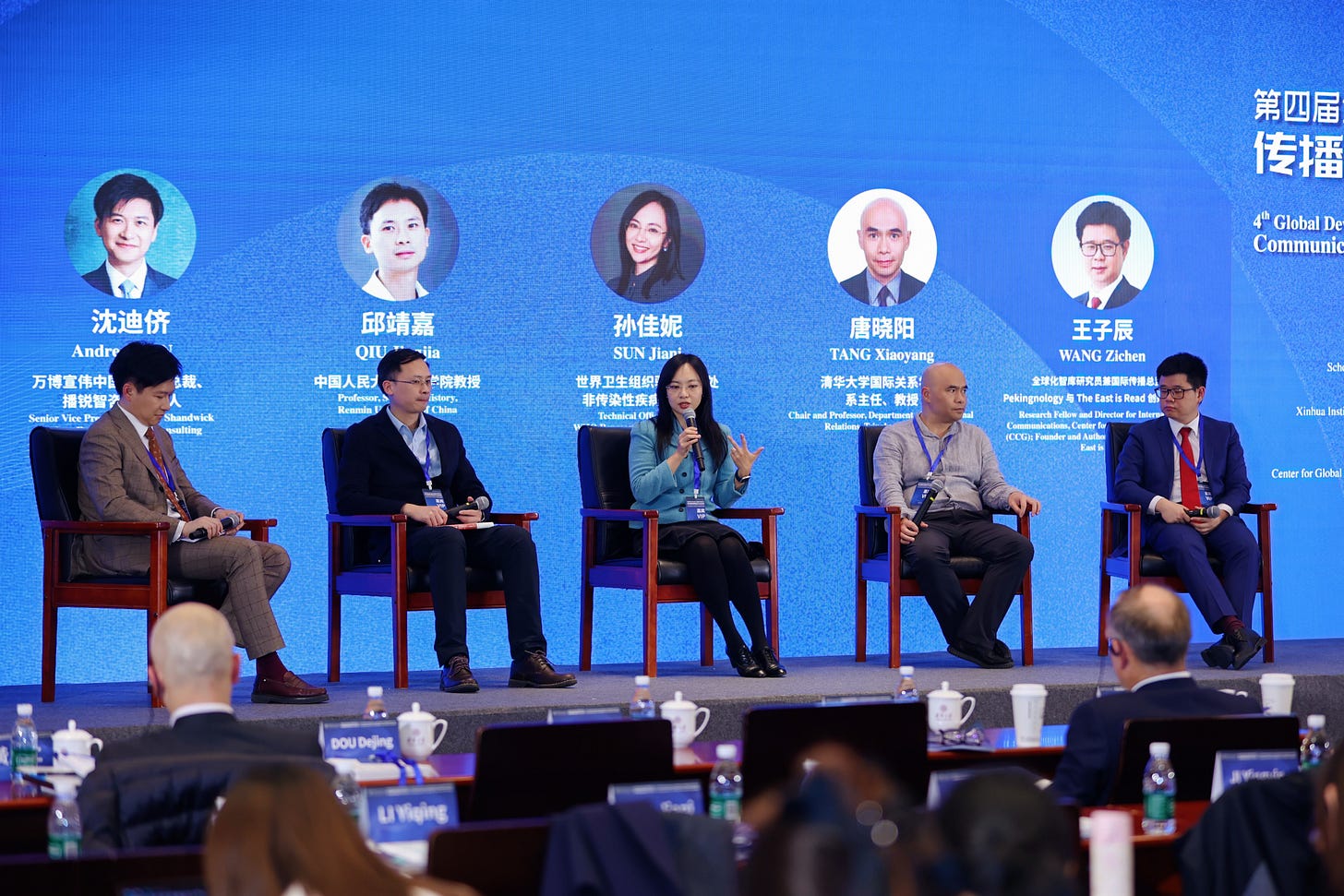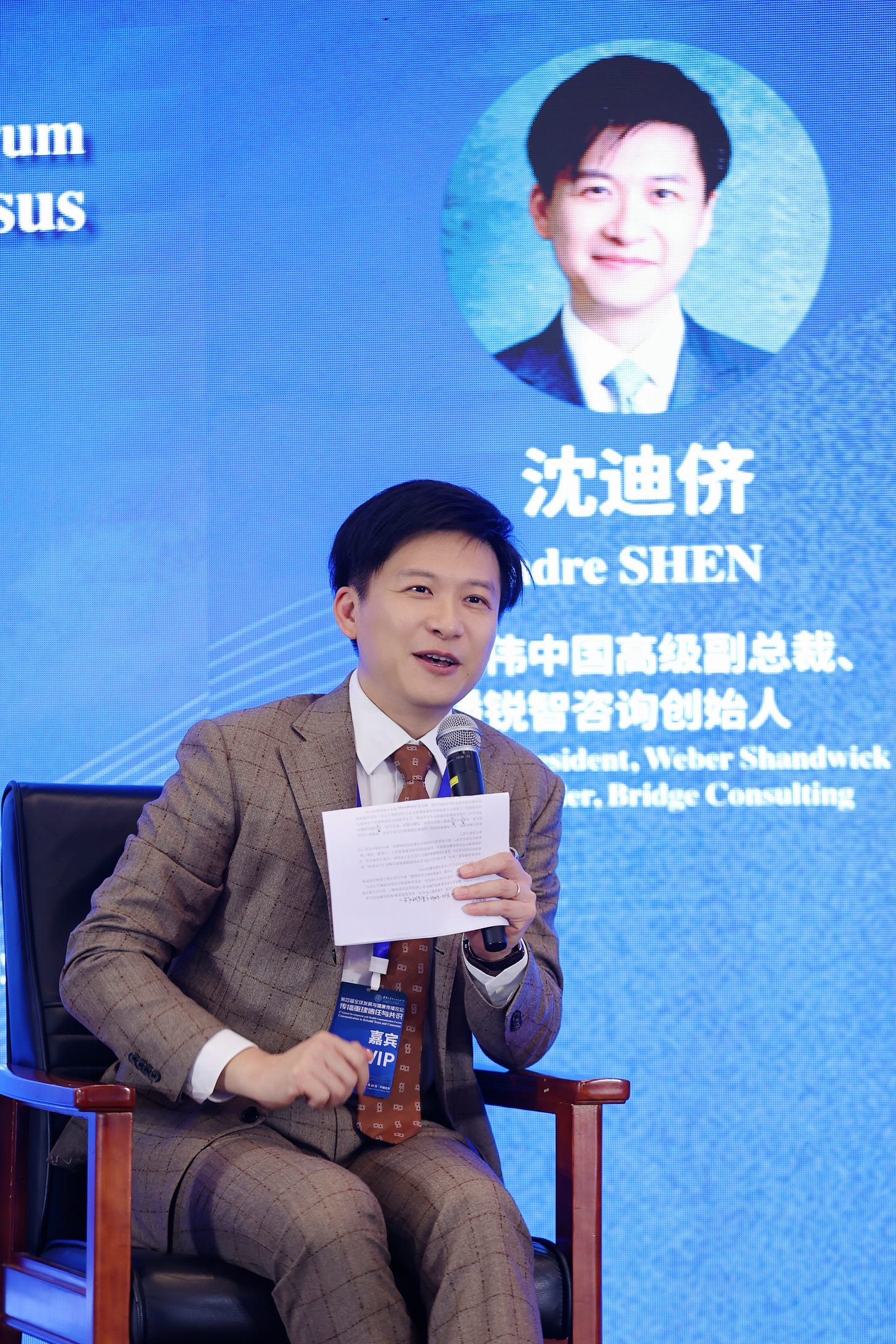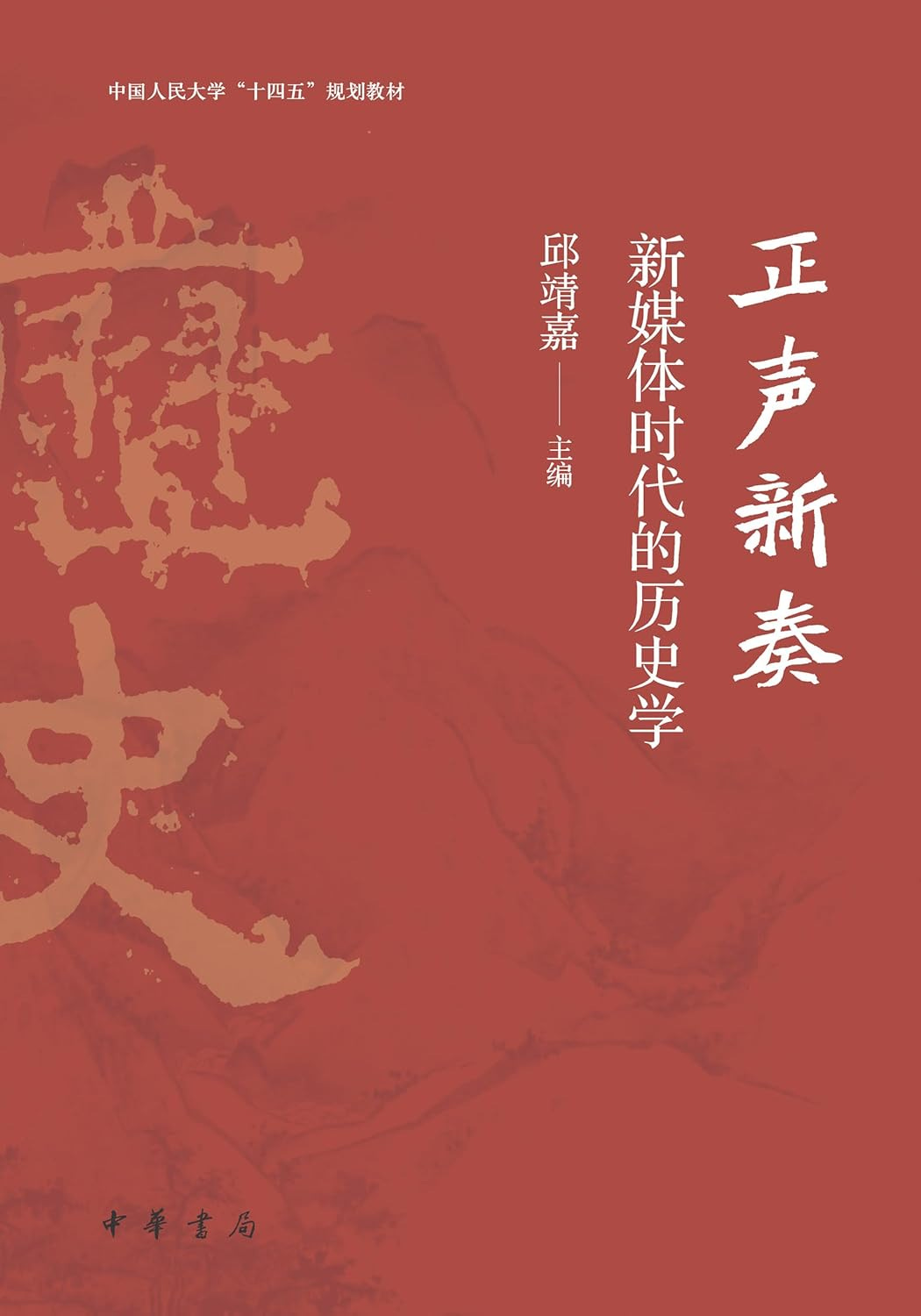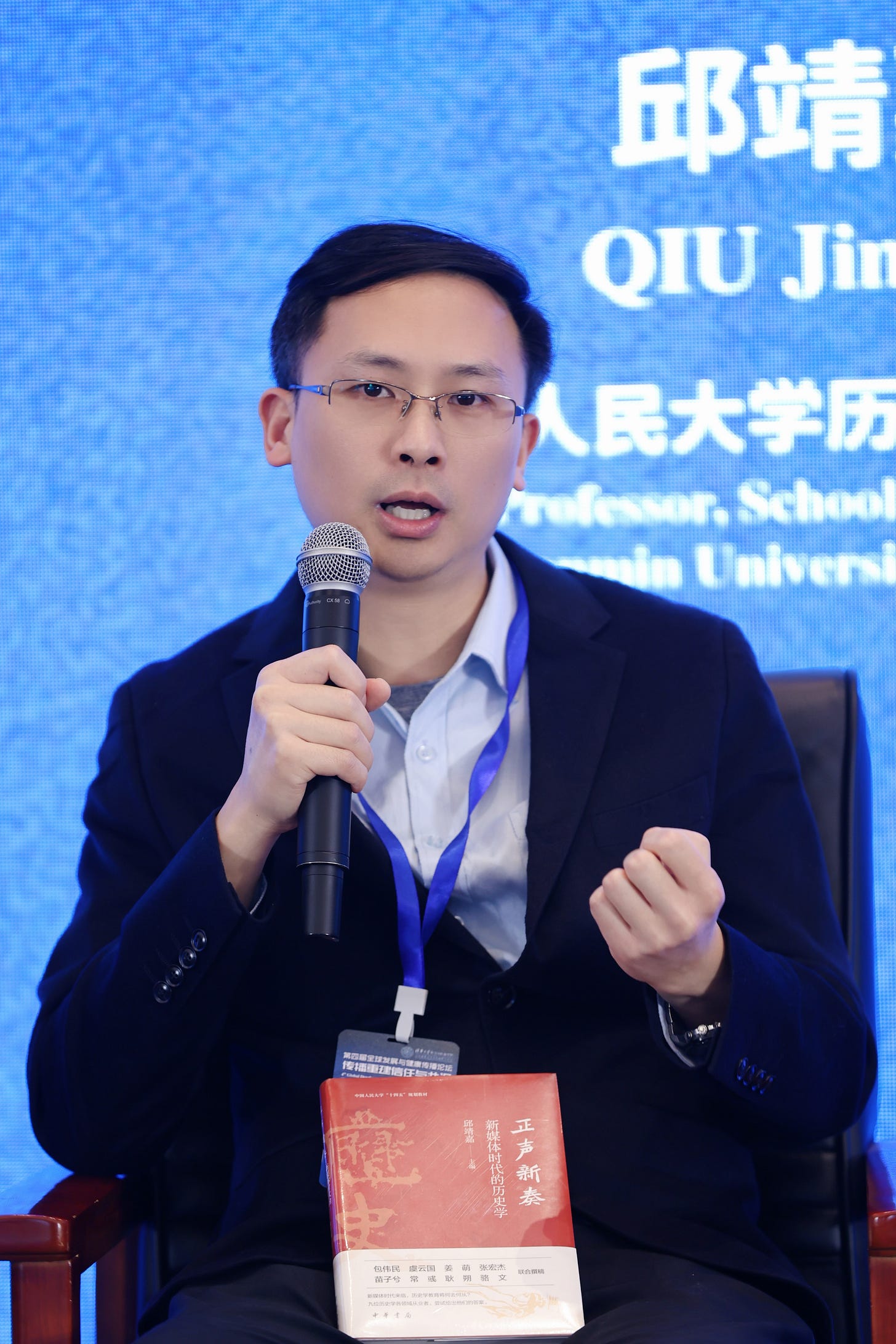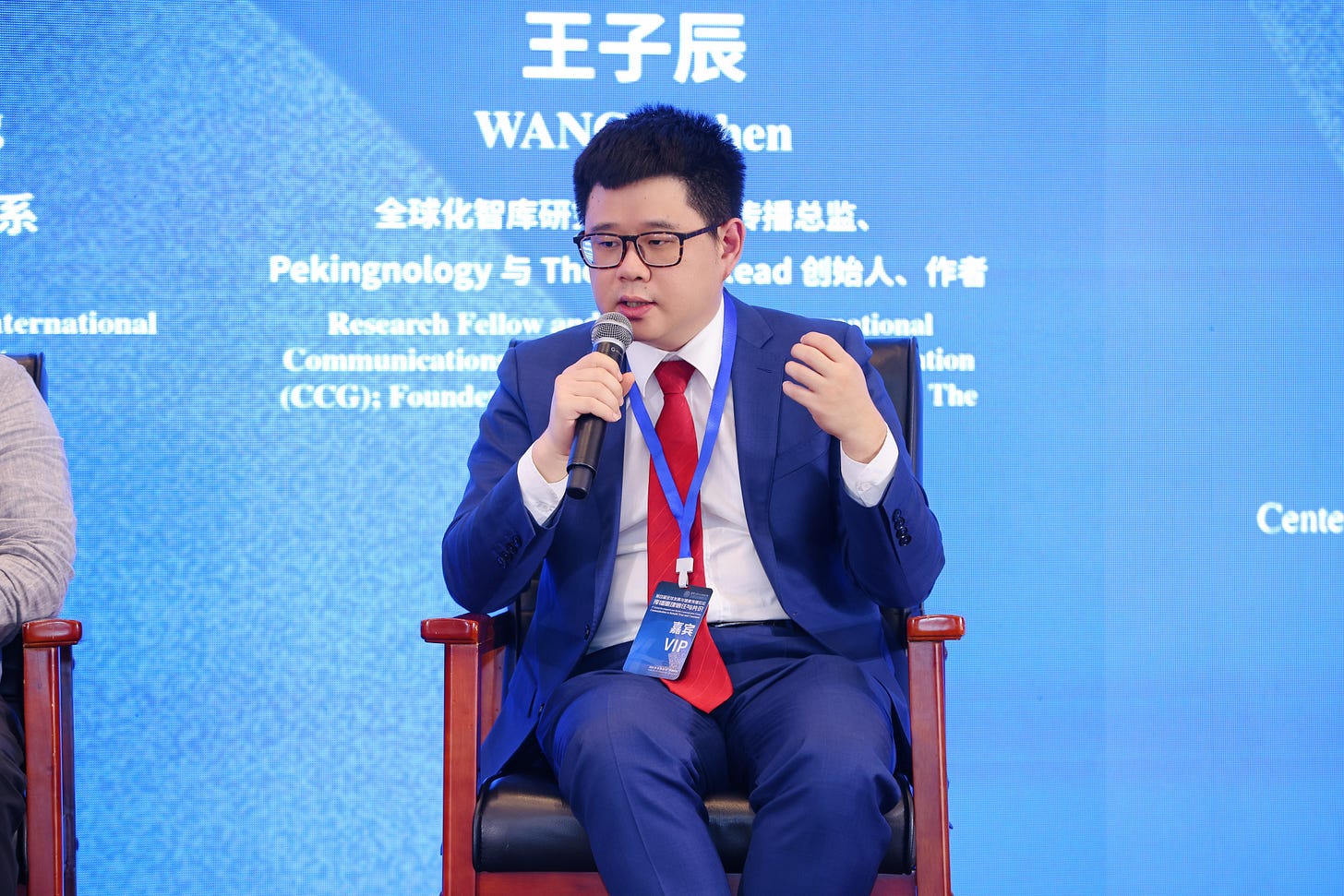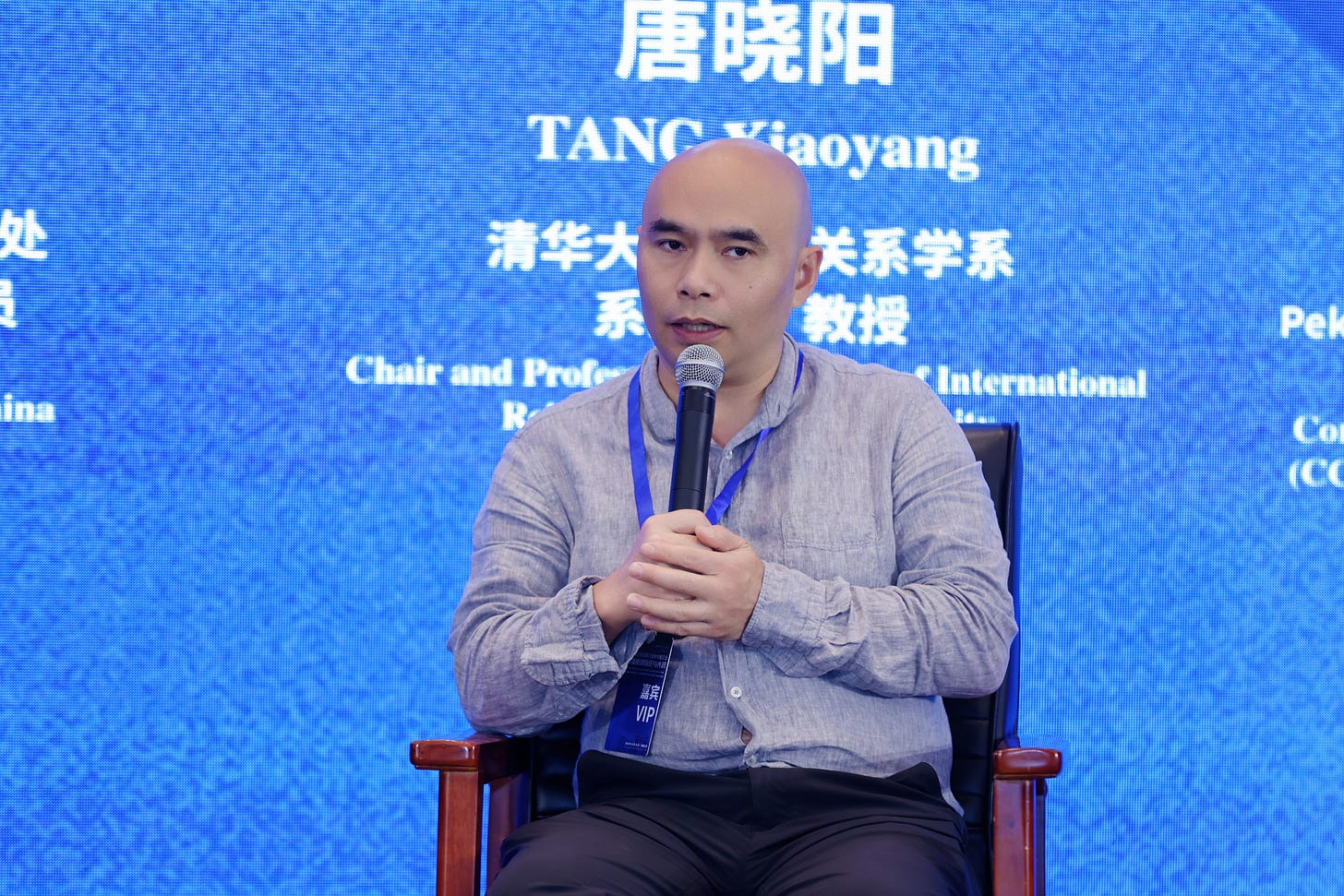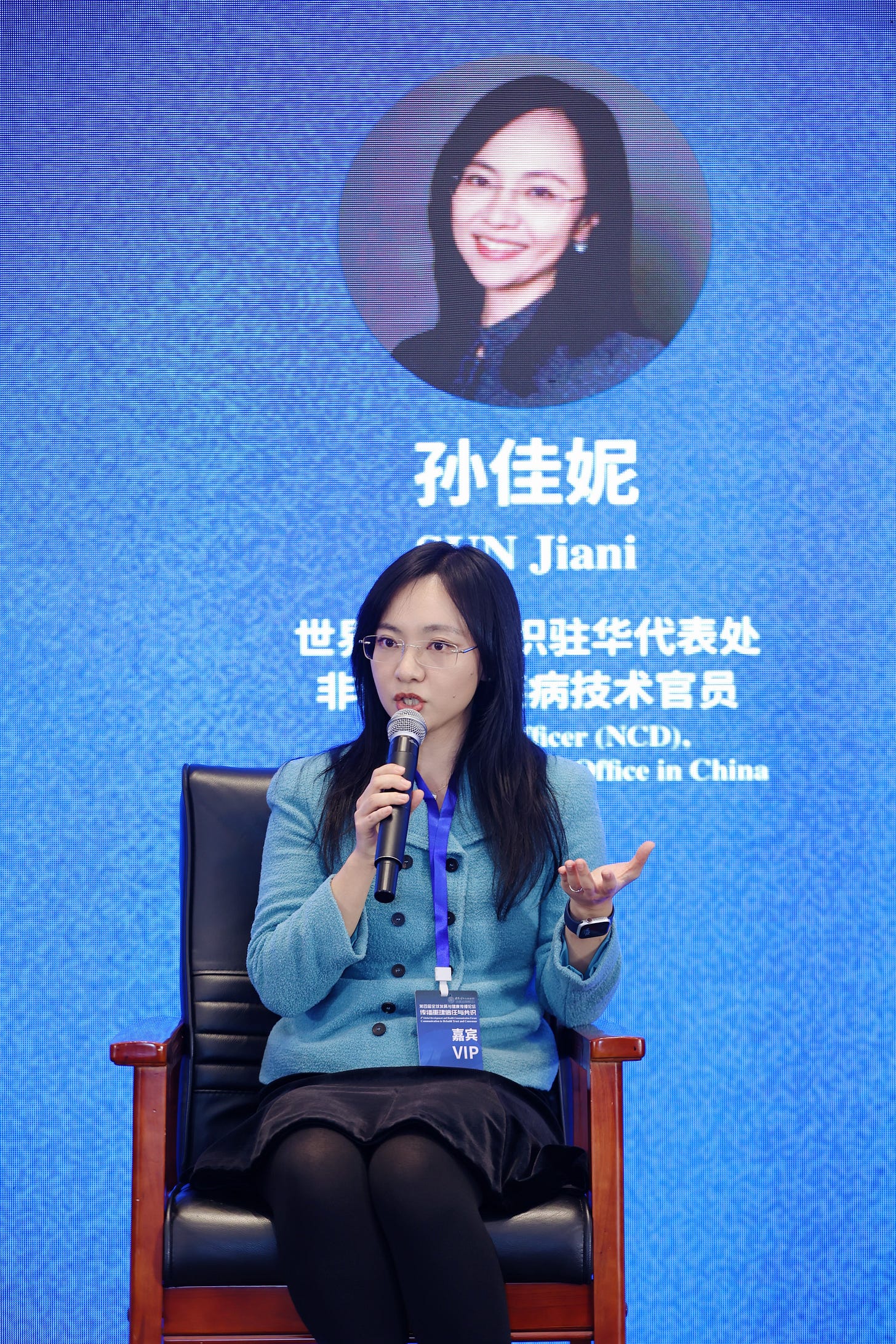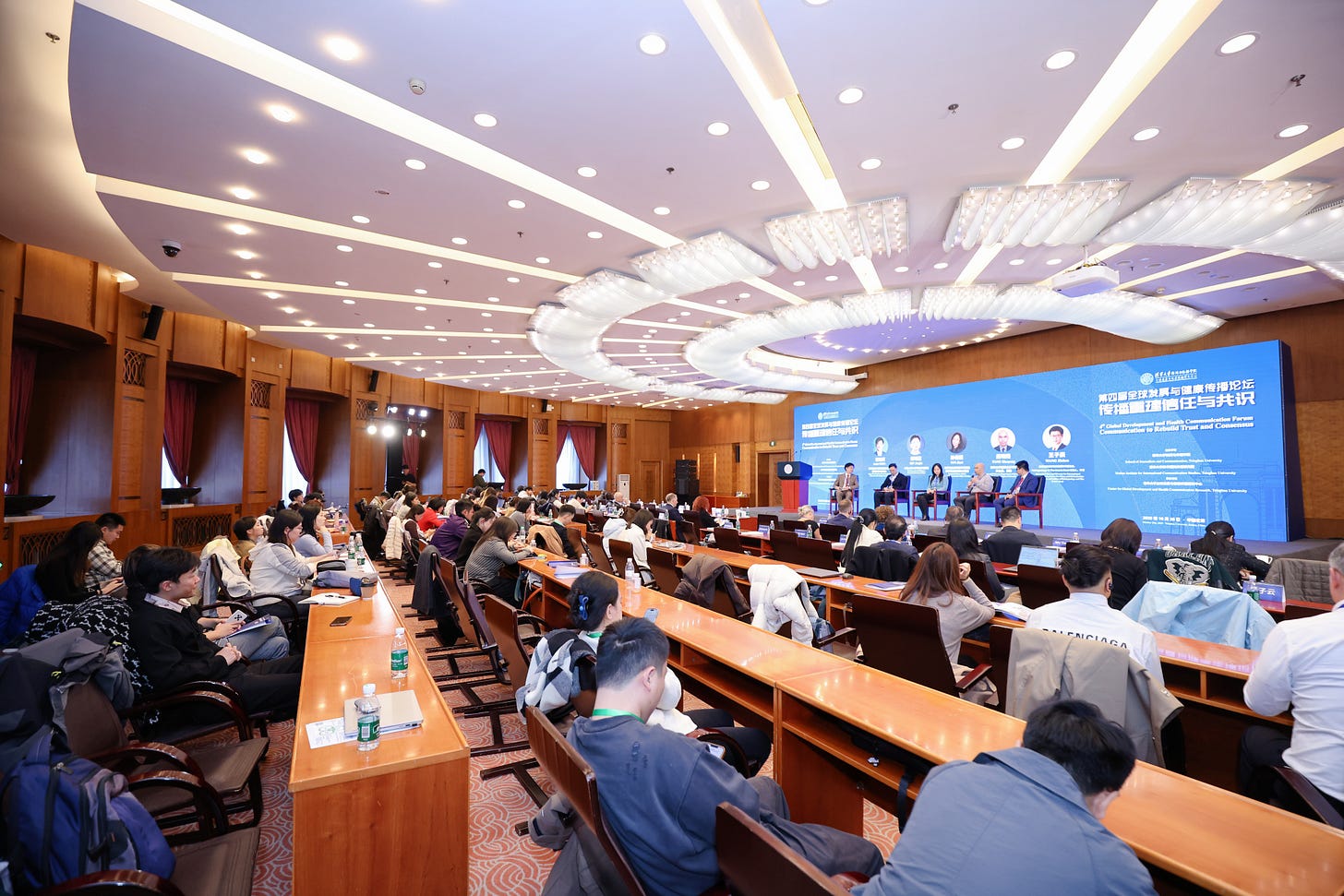Transcript: Panel discussion of Communication as a Public Good
Recap from Tsinghua University’s Global Development & Health Communication Forum on how evidence-based messaging could strengthen cooperation in health and development.
On Sunday, October 26, I had the pleasure of joining the 4th Global Development and Health Communication Forum at Tsinghua University.
I was invited by Andre Shen, who founded Bridge Consulting in 2016 and recently joined Weber Shandwick China as Senior Vice President, to join a panel he moderated to explore one timely question: how can we work together to help rebuild trust in a fragmented world?
Andre invited professionals from journalism, international politics — and, perhaps unexpectedly, history — because he wanted us to take a step back and look at the broader picture of how societies lose and rebuild trust. This framing was inspired by two books: Katharine Graham’s Personal History, which reminds us that “news is the first draft of history,” and Professor Qiu Jingjia’s (正声新奏--新媒体时代的历史学) New Voices of Rectitude: History in the New Media Era, which examines how historical narratives and moral discourse are being reshaped in today’s information environment. What struck me most was how academic and practical perspectives converged — showing that communication isn’t just about narratives, but about shaping understanding, cooperation, and even policy.
Below is the full transcript of our dialogue — a thoughtful exchange on journalism’s social responsibility, the shifting landscape of global health and development, and why rebuilding trust may be the most important global public good of our time.
By the way, if you’re interested in how China’s healthcare sector is emerging as a force for global public goods, check out The Impact Bridge, a new Substack recently launched by Andre and his team.
Moderator:
Andre Shen, Senior Vice President, Weber Shandwick China; Founder, Bridge Consulting
Participants:
QIU Jingjia, Professor, School of History, Renmin University of China
SUN Jiani, Technical Officer (NCD), WHO Representative Office in China
TANG Xiaoyang, Chair and Professor, Department of International Relations, Tsinghua University
WANG Zichen, Research Fellow and Director for International Communications, CCG; Founder and Author of Pekingnology and The East is Read
Q&A question by Paige Snider, Senior Partnerships Advisor, The Pandemic Fund
The panel discussion was conducted in Chinese. The following is a translation.
Andre Shen
I always like to challenge myself by seeing whether it’s possible to bring together people who have never sat on the same stage before — and that was the inspiration for designing today’s roundtable.
While the staff are still arranging the chairs, let me briefly introduce the background. When we were planning this session, the inspiration mainly came from two books.
The first one is Personal History, the memoir of Katharine Graham, the former publisher of The Washington Post. Some Chinese editions translate it as My Life Is Slightly Shorter Than Modern American History.
In the book, she quotes a line from her late husband, Philip Graham: “News is the first draft of history.” That line left a deep impression on me. It reminds us that what journalists write today will shape how future generations understand this era. At the same time, it raises another question for me: if journalism is the first draft of history, then what role do historians play? How should they respond to this age of accelerated information?
The second book that inspired me is New Voices of Rectitude: History in the New Media Era (正声新奏--新媒体时代的历史学), edited by Professor Qiu Jingjia from Renmin University of China.
This book grew out of a teaching experiment at Renmin University about ten years ago. It addressed new characteristics of information dissemination in the age of new media. Professor Qiu, together with Professor Bao Weimin, co-designed a new course titled History in the New Media Era. They proposed a shift away from the traditional model of simply transmitting knowledge toward cultivating students’ historical way of thinking.
So, combining Graham’s insight with Professor Qiu’s research made me realize there must be a subtle yet profound connection between journalism and history. Can the thinking of communication studies and history come together to help us form a more comprehensive and wiser way of understanding the world? That’s precisely why I invited Professor Qiu to join this sub-forum today. Let’s give him a round of applause.
Since we’re talking about connecting journalism and history, I also invited a veteran journalist — Mr. Wang Zichen. Zichen recently earned a master’s degree in public policy from Princeton University and now continues to serve as Research Fellow and Director of International Communications at the Center for China and Globalization (CCG). He is also the founder and author behind several popular Substack, including Pekingnology and The East Is Read. Please welcome Zichen.
Now, today’s theme isn’t just about ideas; it’s also about real-world challenges. In this era of what we might call a “trust deficit,” global cooperation and health development are facing increasing difficulties. Trust between nations — and even between individuals — seems to be in retreat. That’s why we need to open our minds and find new ways to engage with today’s world. So, I’ve also invited two experts from the fields of global health and international development.
The first is Professor Tang Xiaoyang, Chair of the Department of International Relations at Tsinghua University. Professor Tang has long specialized in African studies and issues of international development. Before joining Tsinghua, he worked at the International Food Policy Research Institute and also served as a consultant for the World Bank, the United Nations Development Programme, and several other research and consulting institutions. Welcome, Professor Tang.
And last but not least, Ms. Sun Jiani — someone I’ve known for more than ten years. She is currently a Technical Officer at the WHO Representative Office in China. When I first met her more than a decade ago, she was working on tobacco control and communications at the same time. Later she was transferred to the WHO Western Pacific Regional Office and then spent a short stint at the WHO Mongolia office. Now she’s focusing on noncommunicable diseases (NCDs) at WHO China.
All right, let’s begin by talking about what this so-called “trust deficit” feels like in real life. Is it that there’s simply too much information, making truth hard to discern? Or are we lacking the right way of thinking to make sense of it all? Earlier, I mentioned Professor Qiu. You worked with Professor Bao to develop this course, and you’ve brought your new book as well, haven’t you? Could you please tell us — what exactly is “History in the New Media Era”? What problems does it aim to address?
Qiu Jingjia
I’m truly honored to have the opportunity to participate in this forum today. At first, I thought my discipline — history — didn’t have much to do with the theme of this discussion. But after listening to Mr. Shen’s introduction, I realized that as a historian, I can indeed join this conversation.
The book New Voices of Rectitude: History in the New Media Era grew out of a course I taught at Renmin University. So, what is “history in the new media era”? I don’t mean to define it as a new academic discipline — rather, I use it to describe a social phenomenon.
With the advancement of new media technologies, the way knowledge is disseminated has undergone dramatic changes. This has disrupted traditional historical learning models and posed new challenges, while also making history’s social service function — its role in informing the public — more prominent.
In such a context, how should historians better provide intellectual and cultural content for the public? How can we establish a positive, interactive relationship with society that, in turn, feeds back into our own research and teaching?
The key point, I believe, is that historians must transmit a historical way of thinking to the public. This will help people, in an age of information overload, to sift and judge the flood of “historical” knowledge they encounter — to distinguish right from wrong and to maintain independent thought.
What, then, is the historical way of thinking? Its greatest feature is comprehensive analysis. History emphasizes examining issues through multiple dimensions — time, space, and as many perspectives as possible — to synthesize and understand historical and social phenomena.
For example, when we analyze population issues across time, economists may rely on data models. Historians, by contrast, would combine political, economic, social, and cultural factors to examine their influence on population changes.
Therefore, in the new media era, historians should shift away from a purely academic focus and instead respond to the changing times — meeting the public’s need for reliable historical and cultural knowledge, disseminating up-to-date research findings, and conveying the mindset and methodology of historical inquiry. In doing so, we can help raise society’s overall humanistic literacy.
This, I believe, is the mission and responsibility of historians in the new media era.
Andre Shen
Thank you, Professor Qiu. Now I’d like to turn to Zichen. You started as a journalist, and now you manage multiple newsletters and Substack platforms — reacting quickly to breaking news. How do you interpret the phrase “news is the first draft of history”? What are, in your view, the strengths and limitations of journalism and history respectively when it comes to rebuilding trust and consensus in communication?
Zichen Wang
Thank you, Andre, and thank you to the Tsinghua School of Journalism and Communication for giving me this opportunity to share a few thoughts — especially alongside such distinguished scholars. When you mentioned the relationship between news and history, a very recent case came to my mind.
Just a few days ago, former U.S. President Donald Trump announced a 10% tariff on Canada. His stated reason was that the local government of Ontario had posted an ad on social media quoting a speech by President Ronald Reagan — specifically, a part of his speech that opposed tariffs.
That speech was delivered some 40 years ago, in the 1980s. The Canadian ad excerpted only a short segment — the anti-tariff part — and promoted it online. Trump, upon seeing it, became furious and decided to impose tariffs on Canada. This case vividly shows how journalism and history intertwine.
If you look at the U.S. media, the more liberal or mainstream outlets believed the Canadian ad did not distort history. But conservative outlets and personalities claimed the ad took Reagan out of context, arguing that Reagan had also mentioned exceptions where tariffs could be justified — a part the ad omitted. They deemed it irresponsible communication. Trump even cited it as justification for his new tariffs.
So, the confusion and contestation between “news” and “history” are not just academic — they affect real life, international politics, and trade.
I have two reflections.
First, even in this era of the Internet and AI translation tools such as DeepSeek or ChatGPT, which have greatly reduced language barriers, professional journalists are still indispensable. Continuous, professional news coverage is essential for maintaining an informed public. Otherwise, information fragments, and coherent understanding becomes impossible. Even large language models still depend on these primary journalistic sources.
Second, we are living in an age of fragmented consensus. People struggle to agree — not just because of differing opinions, but because of differing understandings of basic facts. Many disagreements stem from that divergence of “what the facts are.” From this perspective, both historians and journalists play vital roles. Thank you.
Andre Shen
Thank you, Zichen. Let’s now bring the discussion to global health and development. We’ve talked about history and politics, but in the field of global health, we’re also seeing new trends.
For example, after the pandemic, many African countries — among others — are emphasizing local production of essential medicines and vaccines.
At the same time, economies across Europe, America, and Asia are all stressing supply chain restructuring and the creation of “independent and controllable” systems. Globalized division of labor seems to be getting harder.
So, Professor Tang, from the perspective of international relations theory, how do we make sense of this phenomenon? And where might breakthroughs lie — especially for cooperation in global health development?
Tang Xiaoyang
Thank you, moderator. The current push by countries to establish their own supply chains stems from two things: first, the pandemic, when even basic items like masks were hard to obtain and global logistics were disrupted; and second, the larger restructuring of globalization, symbolized by Trump’s tariff wars.
When we talk about vaccines or medical resources, they are indeed linked to short-term security concerns during emergencies. But such concerns are temporary and localized.
In the long run, supply and economics must still follow the logic of cost and efficiency.
So, although the political and security motivations for “localization” are rising, they are not yet strong enough to overturn the efficiency-based logic of global value chains. That’s why U.S.-China tariff negotiations remain ongoing. Trump may hope to “bring everything back to America overnight,” but that’s impossible — industrial and economic realities make it unfeasible.
For many developing countries, the call for localization is not new. Yet because of weak infrastructure and limited industrial capacity, they still rely on global cooperation to maintain stability of supply.
That said, countries can and should make contingency plans — for example, establishing “green channels” for essential goods during emergencies, without necessarily reshoring entire industries. That’s one viable way to enhance resilience.
Andre Shen
Thank you, Professor Tang. Now, Jiani, as both a practitioner and advocate in global health communications, what does “trust” mean to you in public health? In your field — noncommunicable diseases — what benefits can trust bring, and what are the consequences when it’s lacking?
Sun Jiani
I’m very happy to join this fascinating conversation with such distinguished panelists. As the only public health practitioner on this panel, let me share my perspective from that angle.
In public health, just like in any other field, trust is the foundation of cooperation and change.
Take noncommunicable diseases (NCDs), which is my main area of work. I’m not sure how familiar everyone is with them, but NCDs account for three-quarters of all deaths globally — including cardiovascular diseases, cancers, diabetes, and chronic respiratory diseases.
The majority of these diseases, however, are preventable.
Prevention depends on controlling behavioral risk factors — smoking, drinking, unhealthy diets high in salt, sugar, and fat, and lack of physical activity.
But changing behavior is extremely difficult. Personal willpower alone isn’t enough. We need awareness and motivation, but we also need supportive environments that make healthy choices easier and unhealthy ones less visible. We need physicians’ guidance — because, for example, quitting smoking involves addiction.
Throughout this process, trust is decisive. If the public doesn’t trust science, they won’t believe in preventive advice. If they don’t trust policies, they won’t comply. If they don’t trust doctors, they won’t follow prescriptions.
Building trust isn’t instantaneous. It requires scientific evidence and sustained, empathetic communication that helps people understand and believe in science — so they are motivated to change behavior.
Andre Shen
Exactly — as Jiani said, behavior change is never easy. Zichen and I just exchanged a knowing smile — we all know how hard it is to change even when we know a behavior leads to obesity or chronic disease.
That’s why communicators must keep repeating messages in ways that are understandable and trustworthy.
This is exactly what WHO and its partners have been doing for years. Thank you, Jiani.
From our first round of discussion, everyone has offered a different perspective on trust.
Now, assuming we agree that we’re indeed living in an age of trust deficit — where building trust is costly — what can we each do, from our own fields, to rebuild it? Let’s start again with Professor Qiu.
Qiu Jingjia
Let me share some thoughts from a historian’s perspective. What is history? Everyone might have their own idea, but my definition may differ from the usual one.
History is not an objective pile of facts; it’s a narrative — consciously selected, recorded, and written by people. These narratives are often not the whole truth. Some are even rewritten or reshaped to serve those in power.
Take, for example, the “Xuanwu Gate Incident” in the Tang Dynasty. After that coup, Emperor Taizong Li Shimin’s faction systematically rewrote the official Book of Tang. What we now read as “official history” differs greatly from what actually happened. There are many such examples. This raises a question: how should today’s historians and readers view the authenticity of historical records? In a sense, this is also a form of “distrust in history.”
How, then, should we engage with history today? I see several directions:
First, we must critically analyze all sources, sifting through complex narratives to uncover the relatively true record — reconstructing history as accurately as possible.
Second, we must recognize that the very process of rewriting and transmitting history is itself part of human history. Even distorted narratives reveal something about the time in which they were produced.
Third, we should look beyond grand narratives to explore the underlying logic and to observe the vivid lives of individuals.
Only by doing so can we truly understand history. Knowing the past helps us understand the present and foresee the future. Human behavior often follows similar patterns across centuries — history helps illuminate today and tomorrow.
Sun Jiani
From the public health perspective, what matters most is building a bridge between science and the public. A lot of mistrust arises from a lack of understanding of science or from insufficient access to accurate information.
Building that bridge involves two key things:
First, talk about facts. Without facts, it’s impossible to earn trust — misinformation fills the vacuum.
Second, talk about people. We must know our audiences — who they are, what they care about, what language they speak — so that messages reach the right people and help them make the right choices.
For example, everyone knows secondhand smoke is harmful. But when our target audience is non-smokers, just talking about disease risk doesn’t resonate. Instead, we use air pollution indicators to illustrate it — for instance, in a 20-square-meter room where three people smoke, PM2.5 levels can spike to 600. That instantly conveys the severity.
Or take child car seats. Our audience is parents. They care about safety. We tell them: in a 50 km/h collision, a 10 kg child experiences the impact of 300 kg — equivalent to falling from the fourth floor. That visual analogy makes the risk tangible.
Effective science communication combines evidence and empathy. Trust is not built in one go — it requires continuous reminders, repeated engagement, and helping people understand why policies and behavioral changes matter. Only then can public trust gradually take root.
Tang Xiaoyang
I’ll follow up on what Professors Qiu and Ms. Sun just said. I think trust largely arises from the interaction and blending of different people and societies with different histories.
Even for the same fact, understanding can vary drastically depending on one’s background, culture, or experience. For example, when it comes to vaccines, some see collective immunity as a benefit; others focus on side effects or deaths. Perceptions differ across age groups, nations, and cultures.
So how do we build trust? The key is to understand differences and find common ground — or compromise.
In global health cooperation, we all share a common interest in health and life. With enough long-term, reliable data, people can gradually be persuaded — just as smoking bans, though slow, eventually gained acceptance.
It’s also crucial to understand the reasoning behind resistance, instead of dismissing others as ignorant or unscientific. Through practical collaboration — among academia, industry, and NGOs — we can deepen mutual understanding and foster trust.
Zichen Wang
I fully agree with what everyone said, especially Ms. Sun’s practical communication advice.
On a personal level, everyone can contribute — for instance, by improving our social media habits.
Firstly, on platforms like Twitter (or X), I often see people post text-only opinions without sharing sources or links. Adding a simple source — even “from BBC” — takes little effort but helps others fact-check. Even highly educated people sometimes share dubious information, which shows that information hygiene remains a challenge. In this era of information explosion and hyperactive social media, maintaining good information habits is a personal responsibility.
Secondly, when faced with misinformation, silence is not the answer. The remedy is more speech — more factual, evidence-based voices from professionals. I’m glad to see more and more professors on Douyin or WeChat Channels, using their expertise to educate the public. If knowledgeable people stay silent, the public space gets filled with low-quality content.
Since 2020, I’ve been running my own English-language Substack as a form of practice. In China’s international communication field, translation used to be undervalued — people thought “content reposting” lacked creativity. But in English-language discourse, I’ve realized you should never overestimate how much foreign audiences know about China. Many things we assume are “obvious” are, in fact, unfamiliar abroad. So even what seems like simple translation or “content moving” is crucial work.
Andre Shen
What Zichen just said reminds me of David Brooks’s book How to Know a Person. Brooks describes a kind of “disease” — assuming that the world you see is the same one others see.
So, as Zichen said, don’t assume “everyone already knows” something. Many people really don’t. Each explanation, each act of clarification, is part of rebuilding trust and shared understanding.
We still have a few minutes, so I’ll ask one last question before opening the floor.
This question is about long-termism — and about international cooperation. In this fragmented, information-saturated era, how can we sustain long-term efforts — in public health or in historical scholarship — which inherently require patience and persistence?
How can partnerships and collaboration translate into long-term, empathetic communication?
Let’s go in reverse order this time — starting with Zichen.
Zichen Wang
Sure. I want to point out that China’s domestic information environment is quite different from that in the West. Like it or not, the public sector in China has strong capacity to shape narratives and information flows — much more than in the West.
In some ways, this can actually be an advantage for communicating scientific or health information.
Because the public sector has that authority and also values merit — expertise, education, scientific training — this gives science a favorable position in China’s public discourse.
That’s very different from the current situation in Trump’s America. Of course, this doesn’t mean we have no challenges. Even within China’s domestic discourse, a lot of unscientific content circulates widely, while some credible, evidence-based, even officially endorsed information doesn’t spread well.
For example, the Ministry of Agriculture and Rural Affairs has an official WeChat blog that posts scientific information about genetically modified organism (GMOs) — yet its readership is very low, whereas misinformation often goes viral.
So how can we improve?
Public institutions have authority, but they lack the incentives and flexibility of the private sector. Government communication often feels dry, rigid, and unappealing. That’s where the private sector and professional media can play a huge role — especially in health and science communication.
But this requires support — from philanthropic foundations or corporations — because such initiatives are public goods and not profit-driven. We can’t rely solely on individuals’ passion to sustain this work long-term. Thank you.
Tang Xiaoyang
For cooperation to last, the key is simple: all parties must find it beneficial. Only then can it endure naturally.
From that perspective, Trump-style unilateralism — “America First” — cannot last, because it destroys cooperation and yields only short-term gains.
Most countries still see collaboration as essential. It boosts productivity, improves medical efficiency, and enhances public health.
That said, the old model of liberal globalization from the 1990s — driven purely by corporate profit and efficiency — also had flaws.
It ignored the social and political realities of non-Western nations and overlooked cultural diversity.
After today’s turbulence, we may reach a new understanding: Long-term cooperation remains in everyone’s interest. Cooperation must be more inclusive — balancing economic goals with social and cultural considerations.
Sun Jiani
That’s a great question — especially in this fragmented era. Many of us in the public sector often wonder how to sustain communication and build trust long-term.
To be honest, when we see the tiny readership numbers on our official accounts, we sometimes wonder if it’s still worth it (laughs).
But actually, the more fragmented the environment, the more responsibility we have to provide authoritative communication.
As Mr. Wang mentioned, fact-checking is crucial. In the public sector, we must at least ensure the facts are right.
We need to continuously provide evidence-based information and help the public know where to find reliable sources — across AI tools, short videos, social media, or traditional outlets.
Of course, the public sector alone cannot do this. What we need is “alliance-based communication.” We produce scientific evidence and core information. Journalists help interpret policies and explain why they matter. Academics provide supporting evidence and use accessible, human language. Civil society groups and individuals amplify credible messages together. Together, we must reject and avoid spreading unsupported rumors. Only through such an alliance can we truly practice long-termism.
Qiu Jingjia
From a historical perspective, we often say modern society is fragmented — but if you look back, ancient history was just as fragmented.
We piece together the past from scattered, sometimes fabricated records. We must go through a “filtering the false to keep the true” process to form a credible picture of history.
So how do we pursue long-termism in such a fragmented world? I have three thoughts:
Seek truth. History is a quest for truth. Although absolute truth is unreachable, we must get as close as possible to facts, reconstructing history from fragments. Someone once said, “History is a competition of memory and forgetting.” What we remember is only a fraction of what happened. Most is lost. Historical study seeks to recover what has been forgotten.
Focus on individuals. Many people still associate history with kings and great events — cold and distant. But modern historiography focuses on individuals, marginalized groups, and the voiceless — giving warmth to history and connecting it to social reality.
Communicate. Despite the rise of the internet and short videos, public understanding of history is often superficial or distorted. Scholars must step forward to share reliable knowledge and teach people how to think historically. Some historians are already doing popular writing or nonfiction, even experimenting with new media — but it’s far from enough. We need more scholars to engage the public directly.
These three principles — truth-seeking, human focus, and communication — apply not only to history but also to public communication and health. With such “historical care,” we can better address today’s theme — rebuilding trust in times of crisis. Thank you.
Andre Shen
Thank you all.
We only have about three minutes left. Any questions from the audience?
Paige Snider
Thank you. This has been really fascinating, and I wanted to ask a very quick question of Sun Jiani.
Building on what Wang Zichen was saying about how communications in the public sector can be more efficient — in the case of smoking and specifically secondhand smoking, can you describe what you think is the missing ingredient between communications, trust, and consensus?
How do we get China to pass a national smoke-free law, and what has been the barrier to date?
Sun Jiani
That’s an excellent question. In tobacco control, we’ve reached what I’d call the “last mile.” We have facts, evidence, and strong public support — what we still lack is policy.
So how does communication help bridge that?
We need the public and media to help us disseminate these facts and use empathetic storytelling to build public understanding and a supportive environment. Government also plays a key role. As you mentioned, smoke-free legislation is the most effective policy for controlling secondhand smoke and protecting people’s health.
Why don’t we have a national law yet? Some cities — Beijing, Shenzhen, Shanghai — already have local smoke-free laws, and they’ve proven effective.
We need these cities to help gather more evidence demonstrating feasibility; more enforcement data proving operability; and evaluation data showing health benefits — such as reduced exposure, lower smoking rates, and decreased disease burden.
We need academics to collect that data and media to share it widely to strengthen public confidence.
As we said earlier, rebuilding trust requires continuity. Passing a law in Beijing doesn’t end the work — we must continually update public understanding and keep the advocacy alive until a national law becomes reality.
I truly hope to see that day come. Thank you.
Andre Shen
To wrap up briefly — I was really inspired by what Mr. Wang said earlier: that health has a natural advantage as a field — there are universally accepted truths, like “health is better than illness.”
So, as long as we keep communicating these truths clearly — especially to policymakers — and don’t stop just because they sound “familiar,” we can sustain progress through persistence.
Zichen mentioned cooperation; Professor Tang emphasized new mechanisms and new languages of partnership; Jiani talked about bridging science and the public — and, particularly for WHO, also bridging policymakers and scientific evidence.
And Professor Qiu reminded us that many historians are now stepping into the public sphere, offering education and social services, including innovative courses and materials.
In fact, I first learned about his work after seeing his event on PAGE ONE (a bookstore in Beijing) introducing this very book.
So I hope more scholars will step out of the ivory tower, into the public square, to engage broader audiences in important conversations like this.
Thank you again to all four speakers — and to everyone here today.
Chinese think tanks aspire to thrive with independence and internationalization
Global Think Tanks (2.0), written by CCG and published by the People's Publishing House, delves into the mission, challenges, and future development of Chinese think tanks against complexities in the international arena. A book release was hosted by CCG on August 18, 2023, followed by a seminar of leading figures from Chinese think tanks and renowned ex…


